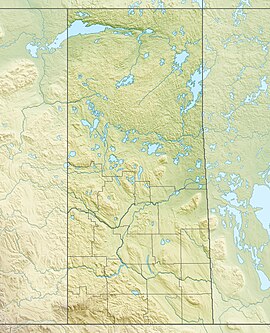The Great Sand Hills,[3] also spelt Great Sandhills, are sand dunes in the south-west region of the Canadian province of Saskatchewan. The Great Sand Hills are the second largest active dunes in Saskatchewan, after Athabasca Sand Dunes, and are part of Great Sandhills Ecological Reserve,[4] which covers an area of about 1,900 km2 (730 sq mi). The sands that make up the dunes are made up of very finely ground sand called rock flour that were deposited near the end of the last ice age. The region around the sand hills is often windy and, as a result, the wind blows the fine sands around creating an ever-changing landscape.[5]
| Great Sand Hills | |
|---|---|
 The Great Sand Hills | |
| Highest point | |
| Elevation | 727 m (2,385 ft)[1] |
| Prominence | 20 m (66 ft)[2] |
| Coordinates | 50°41′54″N 109°17′15″W / 50.6984°N 109.2876°W |
| Dimensions | |
| Area | 1,900 km2 (730 sq mi) |
| Geography | |
| Location | Saskatchewan, Canada |
| Rural municipalities | RM of Clinworth No. 230 |
| Geology | |
| Formed by | Glaciation |
| Age of rock | 12,000 |
| Mountain type | Sand dune |
Swift Current, the fifth largest city in Saskatchewan, is 159 kilometres (99 mi) to the south-east while Leader, the closest town, is 38 kilometres (24 mi) to the north-west. Access is from Sceptre, which is 10 kilometres (6.2 mi) north of the hills. Sceptre is home to the Great Sandhills Museum & Interpretive Centre.[6]
Formation
editThe Great Sand Hills were created over 12,000 years ago near the end of the last ice age as the Wisconsin ice sheet retreated. At that time, the landscape of southern Saskatchewan was much different than it is today as there were retreating glaciers and several proglacial lakes. At the height of the glacial advance 18,000 years ago, the ice sheet was almost 2 kilometres (1.2 mi) thick and as the glaciers retreated, they left behind huge piles of sandy debris, glacial till, and moraines[7] while the melting waters carved out huge spillways. The area of the Great Sand Hills, and nearby Elbow Sand Hills at the headwaters of the Qu'Appelle River in Douglas Provincial Park, was covered by Glacial Lake Bursary. The South Saskatchewan Spillway flowed from the lake and as the glaciers disappeared and the waters began to dry up, sand deltas built up causing the South Saskatchewan Spillway to change course, thereby carving out the South Saskatchewan River Valley. Glacial Lake Bursary dried up exposing the sand deltas, which are the sand hills that exist today.[8][9]
Flora and fauna
editAnimals found around the hills include the mule deer, pronghorn,[10] fox, coyote, white-tailed deer, badger, weasel, porcupine, and the rare Ord's kangaroo rat. Local birds include the sharp-tailed grouse, white pelican, merlin, peregrine falcon, golden eagle, burrowing owl, mourning dove, and sandhill crane. Vegetation around the hills is limited due to the dry conditions and poor soil but includes prairie grasses, sagebrush, and small clumps of trees such as aspen and willow.[11]
Gallery
edit-
Information sign at the Great Sand Hills
-
Great Sand Hills
-
A lone tree at the Great Sand Hills
See also
editReferences
edit- ^ "Maps showing Great Sand Hills, Saskatchewan". Canmaps. Yellow Maps. Retrieved 5 August 2022.
- ^ "The Great Sandhills". Great Sandhills Museum. Great Sandhills Museum. Retrieved 5 August 2022.
- ^ "Great Sand Hills". Canadian Geographical Names Database. Government of Canada. Retrieved 5 August 2022.
- ^ "Unique Places to visit in Saskatchewan". To Do Canada. 21 July 2023. Retrieved 26 March 2024.
- ^ "Great Sandhills". Tourism Swift Current. Tourism Swift Current. Archived from the original on 3 October 2022. Retrieved 5 August 2022.
- ^ "Welcome to the Great Sandhills Museum & Interpretive Centre". Great Sandhills Museum. Great Sandhills Museum. Retrieved 5 August 2022.
- ^ Dale, Janis. "Glacial Deposition". The Encyclopedia of Saskatchewan. University of Regina. Archived from the original on 10 February 2023. Retrieved 5 August 2022.
- ^ Johnston, Dean (9 June 2021). "The Great Sandhills: Saskatchewan's Hidden Gem". Routinely Nomadic. Retrieved 5 August 2022.
- ^ "Great Sand Hills". Tourism Saskatchewan. Government of Saskatchewan. Retrieved 5 August 2022.
- ^ "Pronghorn". Britannica. Encyclopaedia of Britannica. Retrieved 8 May 2024.
- ^ "Great Sandhills". Discover Southwest Saskatchewan. Mooseworld Inc. Retrieved 5 August 2022.
External links
edit- Media related to Great Sand Hills at Wikimedia Commons
- Why are there sand dunes in the middle of Saskatchewan?

